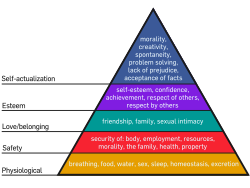NEO-CLASSICAL THEORY :
a) Organisation is basically a social system and not just techno - economical system.
b) Individuals may behave differently under different situations.
1). Human Relations:
Elton Mayo - Founder of Human Relations.
He conducted on experiment on Hawtrone plant of western electric
company and concluded that production efficiency of workers depends upon emotional factors.
He conducted on experiment on Hawtrone plant of western electric
company and concluded that production efficiency of workers depends upon emotional factors.
2) Behavioral Science Approach:
Main contributors - Maslow, F.Herzberg & D.Mc Gregor.
Application of behavioral science such as psychology, sociology & anthropology to the study of human relationship.a) Organisation is basically a social system and not just techno - economical system.
b) Individuals may behave differently under different situations.
c) Attempts should be made to connect organisational goals & human needs.
d) Management must develop social skills in addition to technical skill. Man to man relationship, team spirit & group harmony should be given top preference by management.
MODERN MANAGEMENT THEORIES:
1) Quantitative Approach:
Main contributors – Taylor, Gilbreths, Gantt, Newman &Joel Dean.
a) Management is concerned with problem solving and it must make use of mathematical tools and techniques for the purpose.
b) The different factors involved in management can be quantified and expressed in the form of equations which can be solved with the help of mathematical tools.
c) Management problems can be described in mathematical models.
d) Operation research, mathematical tools, simulation and model building are the basic methodologies developed by this approach.
2) System Approach:
Main contributors – Johnson, Church man, Kenneth, Boulding & Rosen Zweig.
Related to organisation system is defined as – “An established arrangement of components which leads to accomplish of particular objectives as per plan”.
All organisations are open system.
3) Contingency Approach:
Main contributors – John Woodward, Fiedler, Lorsch & Lawrence.
Management is situational & main objective of management is to identify the important variables in the situations.
3 Major parts of overall conceptual frame work for
contingency management
a) Environment
b) Management concepts, principles & techniques.
c) Contingent relationship between (a)&(b) above.















